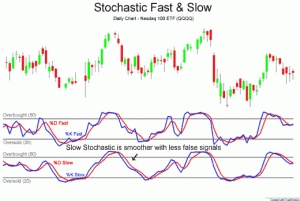Stochastic Oscillator
Trading Forex with Technical Analysis Using the Stochastic Oscillator
 Of the numerous strategies Forex traders employ to help maximise profit potential, combining technical analysis with a system known as a Stochastic oscillator is another very popular method. This indicator measures the current close relative to the highs and lows over a predetermined period of time in the past. Although this is one of the most well-known methods Forex traders employ to follow developing trends, many do not utilise this system in the correct fashion. To understand how Stochastic trading works it is necessary to first examine some basic principles and how they apply to trading.
Of the numerous strategies Forex traders employ to help maximise profit potential, combining technical analysis with a system known as a Stochastic oscillator is another very popular method. This indicator measures the current close relative to the highs and lows over a predetermined period of time in the past. Although this is one of the most well-known methods Forex traders employ to follow developing trends, many do not utilise this system in the correct fashion. To understand how Stochastic trading works it is necessary to first examine some basic principles and how they apply to trading.
A Stochastic chart consists of two lines; a solid line representing the “main line”, or discreet movement, and a second line (usually dotted) which serves as a moving average. What is key here is that these lines correspond with levels on the Forex market which signal to either buy or sell a current position. The general rule of thumb is that if a value falls below 20 points and then rises back, the position is considered oversold and a time to buy. Alternatively, if levels rise above 80, fall below and then breach the mark again, it is a signal to sell, as the position has been overbought and a reversal is likely to occur in the near future. One of the fundamental mistakes traders can make is that this system is only predictive one both ends when observed in a trendless market.
Simply put, if a market is trending higher and values rise above the overbought level, a reversal may not be imminent and therefore one should be careful not to take a bearish stance. Likewise, if a reading falls below the oversold level of 20 and the market is in a downward trend, a significant upward reversal may not follow.
How, then, does a trader use a Stochastic oscillator properly in a trending market? In an upwardly trending market, the buy signals are those with a higher chance of success and should be followed more closely. In a downwardly trending market, the sell signals are those which contain the lowest amount of risk and also need to be followed. Summarily, in an upwardly trending market traders should only look to trade when the Stochastic line falls below and then rebounds above the oversold level (20). In a downward market, one should look to trade when overbought conditions are met; that is, the Stochastic oscillator rises above the overbought level (80) and then returns to the same level.
By incorporating the strategies mentioned above, the Stochastic oscillator can be a powerful tool to capitalise on Forex market movements.
>> Read more about other technical signals





